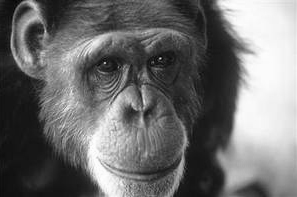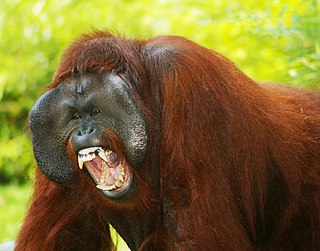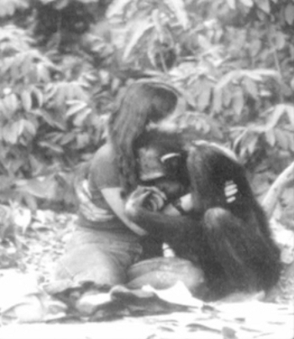Related Research Articles

The chimpanzee, also known as simply the chimp, is a species of great ape native to the forest and savannah of tropical Africa. It has four confirmed subspecies and a fifth proposed one. When its close relative the bonobo was more commonly known as the pygmy chimpanzee, this species was often called the common chimpanzee or the robust chimpanzee. The chimpanzee and the bonobo are the only species in the genus Pan. Evidence from fossils and DNA sequencing shows that Pan is a sister taxon to the human lineage and is humans' closest living relative. The chimpanzee is covered in coarse black hair, but has a bare face, fingers, toes, palms of the hands, and soles of the feet. It is larger and more robust than the bonobo, weighing 40–70 kg (88–154 lb) for males and 27–50 kg (60–110 lb) for females and standing 150 cm.

Neam "Nim" Chimpsky was a chimpanzee and the subject of an extended study of animal language acquisition at Columbia University. The project was led by Herbert S. Terrace with the linguistic analysis headed up by psycholinguist Thomas Bever. Within the context of a scientific study, Chimpsky was named as a pun on linguist Noam Chomsky, who posits that humans are "wired" to develop language.

Washoe was a female common chimpanzee who was the first non-human to learn to communicate using American Sign Language (ASL) as part of an animal research experiment on animal language acquisition.
Yerkish is an artificial language developed for use by non-human primates. It employs a keyboard whose keys contain lexigrams, symbols corresponding to objects or ideas.

Animal languages are forms of non-human animal communication that show similarities to human language. Animals communicate through a variety of signs, such as sounds or movements. Signing among animals may be considered complex enough to be a form of language if the inventory of signs is large. The signs are relatively arbitrary, and the animals seem to produce them with a degree of volition. In experimental tests, animal communication may also be evidenced through the use of lexigrams by chimpanzees and bonobos.

Research into great ape language has involved teaching chimpanzees, bonobos, gorillas and orangutans to communicate with humans and each other using sign language, physical tokens, lexigrams, and imitative human speech. Some primatologists argue that the use of these communication methods indicate primate "language" ability, though this depends on one's definition of language.

Gombe Stream National Park is a national park in Kigoma District of Kigoma Region in Tanzania, 16 km (10 mi) north of Kigoma, the capital of Kigoma Region. Established in 1968, it is one of the smallest national parks in Tanzania, with only 35 km2 (13.5 sq mi) of protected land along the hills of the eastern shore of Lake Tanganyika. The terrain is distinguished by steep valleys, and the vegetation ranges from grassland to woodland to tropical rainforest. Accessible only by boat, the park is most famous as the location where Jane Goodall pioneered her behavioural research on the common chimpanzee populations. The Kasakela chimpanzee community, featured in several books and documentaries, lives in Gombe National Park.
The Chimpanzee and Human Communication Institute (CHCI) was located on the campus of Central Washington University in Ellensburg, Washington. CHCI included a sanctuary for chimpanzees who have learned to communicate with humans and each other using American Sign Language. CHCI's director was Mary Lee Jensvold. It was founded by former co-directors Roger Fouts and Deborah Fouts. The institute was closed in 2013 when the remaining chimpanzees were transferred to facilities in Quebec, Canada and the building the facility was housed in, was demolished in 2018. Portions of the specialized structures used to house the chimps were dismantled and moved to the Chimpanzee Sanctuary Northwest in Cle Elum, for future use.
Loulis is a chimpanzee who has learned to communicate in American Sign Language.

Emily Sue Savage-Rumbaugh is a psychologist and primatologist most known for her work with two bonobos, Kanzi and Panbanisha, investigating their linguistic and cognitive abilities using lexigrams and computer-based keyboards. Originally based at Georgia State University's Language Research Center in Atlanta, Georgia, she worked at the Iowa Primate Learning Sanctuary in Des Moines, Iowa from 2006 until her departure in November 2013. She currently sits on the Board of Directors of Bonobo Hope.

Lucy (1964–1987) was a chimpanzee owned by the Institute for Primate Studies in Oklahoma, and raised by Maurice K. Temerlin, a psychotherapist and professor at the University of Oklahoma and his wife, Jane.
Deborah Fouts was the co-director of the Chimpanzee and Human Communication Institute (CHCI). CHCI was the home of Washoe, the first non-human to acquire a human language, and three other chimpanzees who use the signs of American Sign Language to communicate with each other and their human caregivers. She is an Adjunct Assistant Professor of Psychology (Research) at Central Washington University in Ellensburg, Washington. She is married to former co-director, now retired Roger Fouts.

Experiments involving non-human primates (NHPs) include toxicity testing for medical and non-medical substances; studies of infectious disease, such as HIV and hepatitis; neurological studies; behavior and cognition; reproduction; genetics; and xenotransplantation. Around 65,000 NHPs are used every year in the United States, and around 7,000 across the European Union. Most are purpose-bred, while some are caught in the wild.

Roger S. Fouts is a retired American primate researcher. He was co-founder and co-director of the Chimpanzee and Human Communication Institute (CHCI) in Washington, and a professor of psychology at the Central Washington University. He is best known for his role in teaching Washoe the chimpanzee to communicate using a set of signs taken from American sign language.
A talking animal or speaking animal is any non-human animal that can produce sounds or gestures resembling those of a human language. Several species or groups of animals have developed forms of communication which superficially resemble verbal language, however, these usually are not considered a language because they lack one or more of the defining characteristics, e.g. grammar, syntax, recursion, and displacement. Researchers have been successful in teaching some animals to make gestures similar to sign language, although whether this should be considered a language has been disputed.

Panbanisha, also known by the lexigram , was a female bonobo that featured in studies on great ape language by Professor Sue Savage-Rumbaugh. Her name is Swahili for "to cleave together for the purpose of contrast."

The origin of speech is a topic that has faced consistent problems in explaining how human language evolved. The topic differs from the origin of language because language is not necessarily spoken; it could equally be written or signed. Language is a fundamental aspect of human communication and plays a vital role in the everyday lives of humans. It allows them to convey thoughts, emotions, and ideas, and providing the ability to connect with others and shape collective reality.
Panpanzee the chimpanzee, was born at the Language Research Center at Georgia State University in Atlanta, Georgia. She lived the rest of her life at the Great Ape Trust in Iowa. Her half-brother is Kanzi, a famous bonobo. Kanzi learned 348 lexigram symbols and over 3,000 words from the English language over her lifespan.
Beatrix Tugendhut Gardner was an Austrian zoologist who became well known for the research that she conducted in the United States. She is most well known for her sign language studies with Washoe the chimpanzee, who was the first ape to learn sign language.
References
- ↑ About Friends of Washoe Archived 2012-01-19 at the Wayback Machine Retrieved 2012-01-23
- ↑ Moja's biography Archived 2012-01-01 at the Wayback Machine Retrieved 2012-01-23
- ↑ CENTRAL WASHINGTON UNIVERSITY - references 20 studies Copyright 2004-2009 Chimpanzee and Human Communication Institute Archived 2012-04-18 at the Wayback Machine
- ↑ Robert W. Mitchell, 2002 - Pretending and imagination in animals and children - 370 pages Cambridge University Press, 21 Feb 2002 Retrieved 2012-01-23ISBN 0521770300
- ↑ Herzfeld, Chris (2017). The great apes : a short history. Kevin Frey, Jane Goodall. New Haven. p. 140. ISBN 978-0-300-22137-4. OCLC 982651819.
{{cite book}}: CS1 maint: location missing publisher (link)